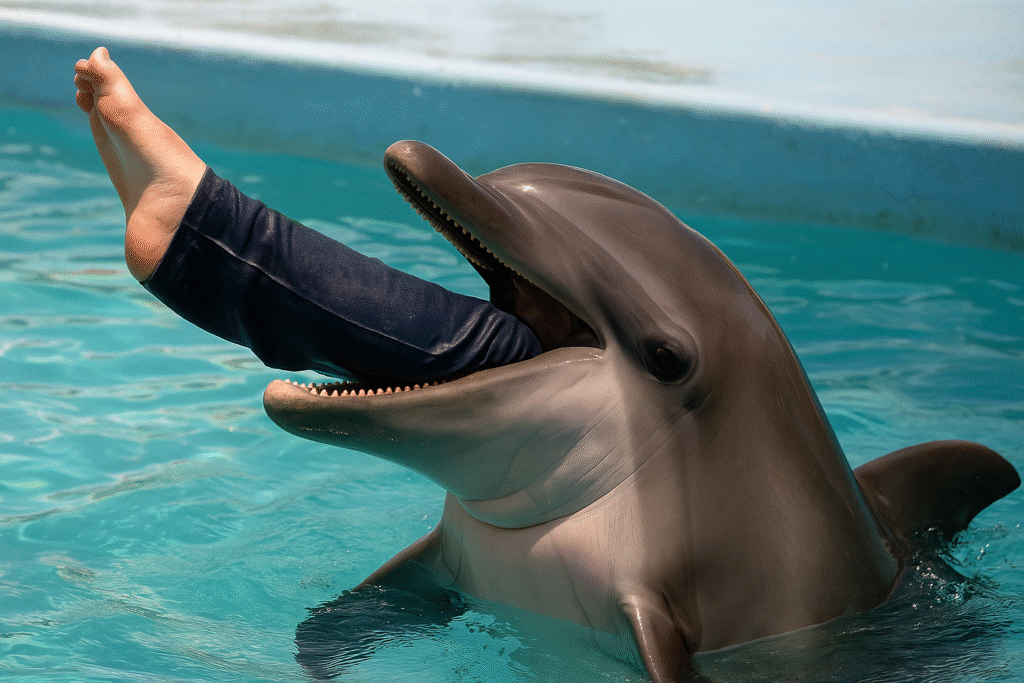
A chilling clip recently scored rounds on social platforms, showing that the dolphin appeared to eat its trainer. The audience was shocked. Some people were frightened; others expressed displeasure. But the truth? There is never any evidence of such an incident. Let’s set the record straight on one of the viral stories.
The Clip That Sparked Panic
On TikTok, Facebook, and X, a woman in a small but dramatic video was recognized as a “maritime mammal trainer,” interacting with a dolphin. Suddenly, the dolphin’s lungs and the trainer disappear underwater. The caption implied it was a shocking attack; many viewers believed it in their intestines, but nothing was added.
Unraveling the Hoax
- No real victim or institution
There is no record of a trainer with that name, nor did any marine park state such an incident. Hospital, Security Authority, and Press Outlets – all silent.
- Digital red flags
Experts note that the audio of the clip seems artificial. Crowd reactions and statements are flat and strangely bookish. Visual lacks stability – dolphin movements are not in sync, and splashes are digitally mixed.
- AI comes from archival footage.
They combined the video, adding the scenes of Orca Marine Park edited with AI-borne audio and video overlay to create a solid forgery, real footage, and synthetic elements.
- Capitalization on actual tragedy
Hocx borrows elements from real marine mammal events – such as trainers who have tragically lost their lives in orca accidents – at a glance, seem admirable.
Why People Believed In It And Shared It.
- Emotional shock value: intestinal-ravaged or shocking material draws us inside. It triggers sympathy and fear, which inspires immediate reactions-like sharing.
- Algorithm amplification: Platform Value Engagement. Visual and sensational claims rapidly spread, fuelling time and materials.
- Suspension of mistrust: When graphics look real, people often give up doubt-especially when the details match the fears of real life.
Real Sea Mammal Events – Rare, Tragic, Well-Documented
While this video is the story, there are fifty rare aquatic animal attacks.
- In 2010, an experienced orca trainer at a marine park died tragically when Wa Hale pulled her underwater during a demonstration. The incident brought changes in security policies and became central for public debate on animal captivity.
- In 2009, a dolphin or orca badly injured a trainer in another park during a rehearsal. These were isolated, not sensational, anonymous stories presented by well-explored tragedies and hoaxes.
Such actual cases are painful, severe, and well documented not flow under the statements of the script style. Hocx’s video takes advantage of these real tragedies to feel reliable.
Comprehensive Text on Digital Misinformation
This fabricated clip is a prime example of how much modern deception has developed:
- AI makes it real: Deepfakes and synthesized audio can create almost lifelike views.
- Sells wrong reference: Adding false claims to real events gives them an anchor of credibility.
- The audience matters to the responsibility: share every scroll, reaction, and fuel false stories. Stopping to evaluate – even when charged emotionally – is important.
If You Face Such A Clip …
- Stop before reacting.
- Question Reliability: Who posted it? What is a source?
- Search for Reporting—Are the prestigious media outlets or experts addressing it?
- See for infallible details: AI often remembers realistic human movement or natural audio signals.
Final Thoughts
Despite the viral clip, no dolphin ever ate a trainer—that part of the Internet fiction firmly argues. The trainer is not present, the facility does not exist, and no legitimate report supports any of it.
This Hoax explains more about our digital age of marine predators – it creates sensational fear, blurs the fact and imagination with deep technologies, and emphasizes the importance of critical thinking.

